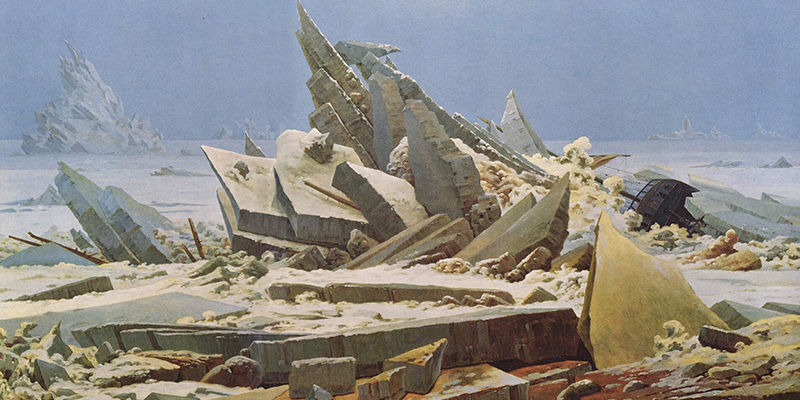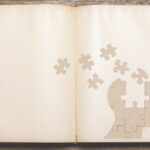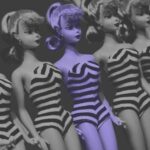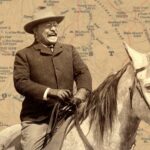I now own two editions of Frankenstein whose cover illustrations prominently feature icebergs. The first one I acquired, a Broadview Edition, I bought for an undergraduate class. Its cover design is a full-page, blue-tinted, grainy photograph of a gigantic, pyramidal spike of ice, with the title of the book and other relevant information in a neat, white text box in the center.
The second is a Norton Critical Edition I purchased for a grad school course. Its iceberg is different—the focal point of an eerie 1824 painting then called “The Polar Sea” by Caspar David Friedrich (now it is called “Sea of Ice”). Glacial images, though, do not seem to be the most popular choice for Frankenstein covers (based on a cursory internet search, at least), with many of the book’s manifold editions visually acknowledging its most famous character—the Monster—and with many of these, in turn, associating the book and its Monster with an image from the relevant pop culture horror pantheon, often the famous Boris Karloff visage, complete with neck bolts and an enhanced supraorbital ridge.
With their covers, the Broadview and Norton editions are emphasizing an aspect of the Frankenstein story that gets left out of movies—the epistolary framing narrative written by the lonely, Arctic-immured Captain Walton, who hears the story of the mad scientist and his monster-creation straight from the Modern Prometheus, himself, after finding Frankenstein dying on one of the floes in a failed, final pursuit of his creature. The Norton Edition’s iceberg, though, does more than establish the story’s actual setting, and emphasize that many of the novel’s main themes run through the multi-layered framing device that is Captain Walton’s frozen ship (such as ambition to know and control the natural world, or the desire for friendship/companionship); Freiderich’s painting, with its towering, jagged spires, depicts, off to the side, the wreckage of a wooden ship, dwarfed when juxtaposed with and easily splintered by the giant crystals of ice—and is notable for its stressing the breathtaking prettiness and dangerous mortality of the scene, elements which correspond to the concepts of the Sublime and the Beautiful as developed by Edmund Burke, among others. Indeed, Frankenstein teems with sublime imagery, and it is used, along with references to weather and climate patterns, race-creating metaphors and allusions to parental Biblical activity, and a theme of powerlessness against stronger forces, to build a criticism against human beings believing that they can know and master all.
The word “sublime” is used seven times in the text, and, in many scenes, humans marvel at the magnificence, scale, and powerfulness of nature. Young Frankenstein is even impelled to learn more about science and electricity (which many movies represent as the jolt that animates the Monster’s corpse, though in the book, Frankenstein’s life-giving scientific process is kept obscure) after watching a tree get smote by lightening. He is excited by the power he sees in nature, and desires to master it by creating human life from dead matter.
He ends up enlivening his gigantic, superhuman monster “on a dreary night in November” while it is raining. Here, the reference to the darkness and the weather on the night the Monster was born mirrors the fabled circumstances from which the book Frankenstein was created; according to the preface Percy Shelley wrote for his wife, her story Frankenstein was incepted at night, during a rainy season.
The Monster was born during harsh weather conditions, and, in the novel, his coming is usually preceded by harsh weather, and natural conditions which constitute the Sublime. When Robert Walton sees him on the dogsled, out on the ice, the Monster is barely visible through curtains of fog and sheets of ice. During a violent storm after he has returned home (after William’s murder), Frankenstein sees the Monster by the light of a lightening flash, for the first time since abandoning the laboratory. When the Monster confronts Frankenstein, it is raining and they are atop a mountain peak (where Frankenstein has craved to go, because “the sight of the awful and majestic in nature had indeed always the effect of solemnizing my mind and causing me to forget the cares of life.” It is raining powerfully when the Monster strangles Elizabeth on her wedding night. The power, scale, and august danger of the Monster matches that of nature, so much so that nature foreshadows, and becomes a proscenium for, the Monster. The Monster is both a person, and a force of nature (which is what Frankenstein has rather longed to be).
Though Frankenstein has been fascinated by science since childhood, his desire to become a scientist is confirmed when he meets Waldman, his future university teacher and mentor. Waldman expounds, during a lecture,
“…but these philosophers, whose hands seem only made to dabble in dirt, and their eyes to pore over the microscope or crucible, have indeed performed miracles. They penetrate into the recesses of nature and show how she works in her hiding-places. They ascend into the heavens; they have discovered how the blood circulates, and the nature of the air we breathe. They have acquired new and almost unlimited powers; they can command the thunders of heaven, mimic the earthquake, and even mock the invisible world with its own shadows.”
Frankenstein is moved, and then has this same ambition: to “unfold to the world the deepest mysteries of creation.” Indeed, his ambitions surpass science and skirt metaphysics—he plays with creation, desires to form his own race of people, longs to master nature; he builds his creature, which he refers to as a new Adam, even more powerful than himself.
He longs to be like God as a creator, but fails at being God as a father/parent, abandoning his progeny in fear. He has, in attempting to play God, created something he cannot, or will not be able to, control. He doesn’t even own up to this until the Monster has killed nearly everyone about which he cares—after Elizabeth is murdered, Frankenstein devotes his life to destroying the Monster he once produced, with an ambition that almost mimics his prior ambition—to harness that which cannot be harnessed. Frankenstein believes he has failed, when he creates the Monster, and so abandons him—he does not realize that he still has it within his power to make his experiment succeed, by giving the Monster the father, friend, or creator he will come to crave.
While finally hunting for the Monster, he is weakened by the Arctic weather conditions and would almost die on the ice if Walton didn’t find him. The natural world which he has built his monster to weather has ultimately weathered him—in a sad cycle, Frankenstein calls himself the “blasted tree” that had inspired him to harness nature, to begin with. Frankenstein becomes the ruins of nature, while the Monster IS nature, in all its might—while hunting him, Frankenstein hears the Monster laugh at him, and this great laugh is echoed by the nearby mountains. Nature and the Monster ultimately become one, here—both untamable and undaunted at the prospect of someone even attempting to do just that. Just as the Monster, in his power, is impervious to the Arctic conditions, Frankenstein is not, and he is destroyed by the very scale, and powerfulness he was once able to create.
Frankenstein’s ability to destroy, though, is more powerful than his ability to create… and ultimately prevents larger destruction. The two times in the novel when Monster appears to a narrator when it is not raining, take place at night, and both feature the destruction of something by Frankenstein—the first is when he watches Frankenstein create the female Monster (and then destroy her, and the second is when the Monster appears to Frankenstein’s corpse on Walton’s ship. The first is an active decision, and the second is passive—but they are both accompanied by a giant moon and clear skies. Nothing is sublime, in these two scenes—Frankenstein is grounded and longs to protect instead of produce. His abilities to curb his actions, or ultimate inabilities to carry on with something dangerous or powerful (by refusing not to build a monster, or by not being able to carry on their fight), end problems before they begin. While these actions cannot stop nature, or undo more powerful forces, they can prevent problems from escalating.
Frankenstein tells Walton as much, before he dies—that pursuing the Arctic campaign is not worth the sacrifice, and will only add to unfortunate events. Walton can be seen as a combination of the Monster and Frankenstein—he is self-taught, friendless, and longs to beat the harsh weather and climate conditions that he faces. Frankenstein’s death not only ends the feud with the Monster, but saves the ship and all of its crewmen from a terrible fate. He saves their families from suffering. Frankensetin’s own destruction, then, is possibly the most powerful thing that he has ever done.

















